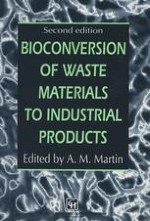1998 | OriginalPaper | Buchkapitel
Bioprocessing of agro-residues to value added products
verfasst von : V. S. Bisaria
Erschienen in: Bioconversion of Waste Materials to Industrial Products
Verlag: Springer US
Enthalten in: Professional Book Archive
Aktivieren Sie unsere intelligente Suche, um passende Fachinhalte oder Patente zu finden.
Wählen Sie Textabschnitte aus um mit Künstlicher Intelligenz passenden Patente zu finden. powered by
Markieren Sie Textabschnitte, um KI-gestützt weitere passende Inhalte zu finden. powered by
Vast quantities of agricultural and agro-industrial residues that are generated as a result of diverse agricultural and industrial practices represent one of the most important energy-rich resources. Accumulation of this biomass in large quantities every year results not only in deterioration of the environment but in a loss of potentially valuable material which can be processed to yield a number of value added products such as food, fuel, feed and a variety of chemicals. A few of these potential residues are listed in Table 5.1. While cellulose, hemicellulose and lignin are the major constituents of these lignocellulosic residues, minor quantities of protein, pectin, soluble sugars, vitamins and minerals are also present. The composition of these residues, which depends on the age of the plant, is also different in different parts of the same crop, such as stalks, stems, straws, hulls and cobs. A correct analysis of the carbohydrates and other chemical components of lignocellulosic residues is of utmost importance for the evaluation of effectiveness of pretreatment method, product yield and process design. The limitations involved in comparison of data from different laboratories have been discussed by Saddler and Makle (1990). Using recent methods for their analysis, the carbohydrate components are first hydrolysed to monomeric sugars which are then estimated by gas chromotography (GC) or high-pressure liquid chromatography (HPLC). Based on the monomeric sugars, the relative amounts of the corresponding polymers from which they are derived, i.e., cellulose and hemicellulose, are calculated stoichiometrically (Karr et al., 1991; Puls, 1993; Hayn et al., 1993). This procedure also allows the determination of relative amounts of soluble sugars in the lignocellulosic biomass. The composition of a few lignocellulosic residues is summarized in Table 5.2.
